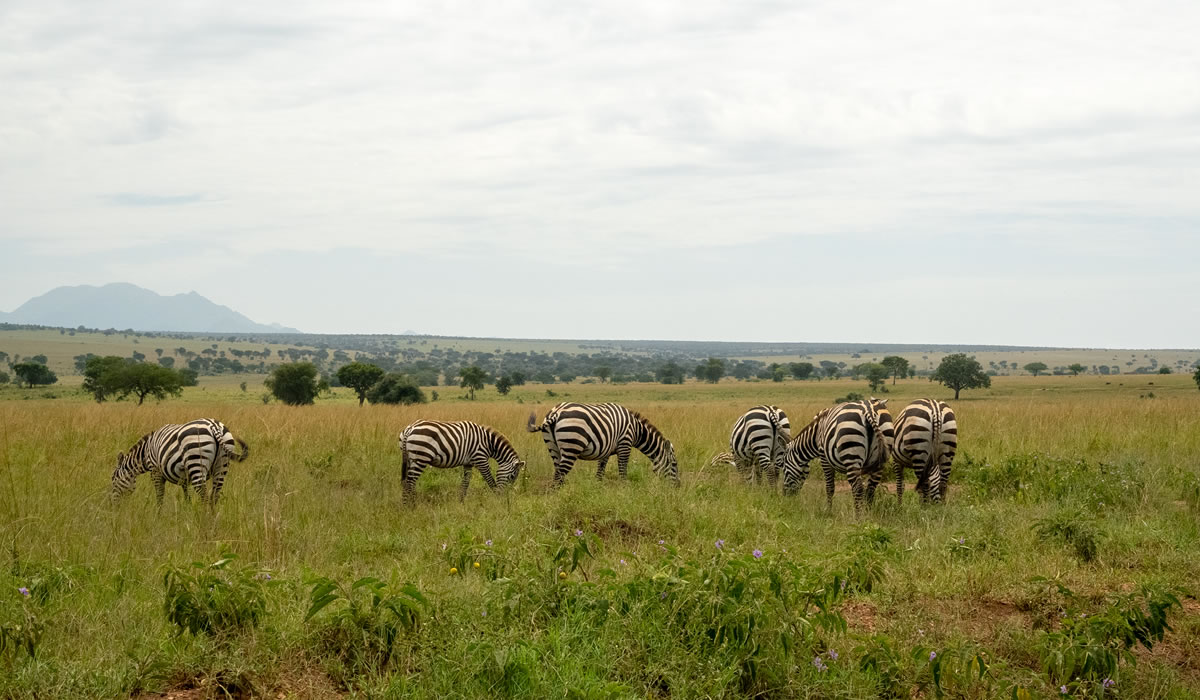Kidepo Valley National Park, located in the remote northeastern corner of Uganda, is one of the country’s most untouched and spectacular wildlife destinations. Covering over 1,442 square kilometers, Kidepo is celebrated for its vast savannah landscapes, dramatic valleys, rugged mountains, and abundant wildlife. The park lies in the Karamoja sub-region, bordering South Sudan to the north and Kenya to the east, and is considered a gem for adventurous travelers seeking a true wilderness safari experience. With its remote location, Kidepo offers an authentic safari away from the crowds, pristine ecosystems, and encounters with rare wildlife, making it a must-visit for anyone exploring Uganda.

Scenic Landscapes and Ecosystems
Kidepo Valley National Park is characterized by a mix of savannah plains, acacia woodlands, rocky hills, and montane ecosystems. The park is divided into several zones, including the Narus Valley, Kidepo Valley, and Loima Mountains, each offering distinct landscapes and habitats. The Narus Valley is dominated by expansive grasslands and seasonal rivers, providing excellent grazing areas for large herds of herbivores. The Kidepo Valley itself is a wide, open plain dotted with termite mounds, acacia trees, and scrub vegetation, offering scenic vistas and prime wildlife viewing opportunities.
The park also contains rugged mountain ranges such as Mount Morungole, Mount Zulia, and the Loima Hills. These elevations provide stunning panoramas over the savannah below and serve as critical habitats for mountain-adapted species. Seasonal rivers, wetlands, and pans create a mosaic of ecosystems, supporting diverse flora and fauna while providing essential water sources for wildlife during the dry season.
Wildlife in Kidepo Valley National Park
Kidepo Valley National Park is home to one of the highest concentrations of wildlife in Uganda, particularly for large savannah species. The park hosts over 77 mammal species, including elephants, lions, cheetahs, leopards, African wild dogs, hyenas, buffaloes, giraffes, zebras, and various antelope species such as oribi, hartebeest, and impala. Predators are abundant, and sightings of lions hunting on the plains or cheetahs stalking prey are particularly thrilling for safari enthusiasts.
The park is renowned for its large elephant herds, especially in the Narus Valley, where up to 200 elephants may congregate during the dry season. Buffaloes roam the grasslands in massive herds, while giraffes and zebras add to the quintessential African savannah landscape. Unlike other parks in Uganda, Kidepo offers the chance to see African wild dogs in their natural habitat, a rare and exciting experience for wildlife lovers.
Birdwatchers will find Kidepo Valley National Park equally captivating. With over 470 recorded species, the park is a haven for birding enthusiasts. Species such as the kori bustard, ostriches, secretary birds, and the rare Nubian eagle thrive in the open savannah. The park’s acacia woodlands and riverine forests provide habitat for colorful sunbirds, hornbills, bee-eaters, and the elusive black-faced firefinch. Seasonal migratory birds also visit Kidepo, adding to the diversity and excitement for ornithologists.
Activities in Kidepo Valley National Park
Kidepo Valley National Park offers a variety of safari activities that cater to adventurous travelers, wildlife enthusiasts, and photographers.
Game Drives
Game drives are the most popular way to explore Kidepo, with early morning and late afternoon safaris offering the best chances to observe predators and active wildlife. Guided by experienced rangers, visitors can track elephants, lions, cheetahs, and buffaloes across the expansive savannahs. The park’s open landscapes make wildlife spotting relatively easy compared to dense forests, and the dramatic scenery enhances the overall safari experience.
Guided Walking Safaris
Walking safaris in Kidepo provide an intimate and immersive experience. Accompanied by trained guides, visitors can explore the grasslands, dry riverbeds, and rocky hills on foot, learning about animal tracks, medicinal plants, and the ecosystem. Walking safaris also offer unique photographic opportunities and a deeper connection to the natural environment.
Birdwatching Tours
Kidepo is a world-class destination for birdwatching, and specialized birding tours can help enthusiasts spot rare and endemic species. Guided birding excursions take visitors through savannahs, woodlands, and riverine forests, providing detailed insights into avian behavior, habitats, and seasonal patterns.
Cultural Experiences
Kidepo Valley National Park is located in the Karamoja region, home to the Karamojong people. Cultural tours offer visitors a chance to interact with local communities, learn about traditional pastoralist lifestyles, see beadwork, crafts, and ceremonies, and understand the relationship between the people and the land. These experiences enrich the safari and promote sustainable tourism that benefits the local communities.
Night Safaris and Sunset Drives
Night drives in Kidepo are a rare and exciting activity, allowing visitors to observe nocturnal species such as hyenas, jackals, and porcupines. Sunset drives provide stunning photographic opportunities, with the golden light illuminating the savannah, wildlife silhouettes, and distant mountains, creating a quintessential African landscape experience.
Accommodation in Kidepo Valley National Park
Accommodation options in Kidepo Valley National Park cater to different types of travelers, from luxury safari seekers to those on a budget. High-end lodges like Apoka Safari Lodge, Kidepo Savannah Lodge, and Narus Camping Sites offer comfort, spectacular views, and easy access to safari activities. Mid-range accommodations such as Karamoja Safari Camp provide cozy stays with guided tours and organized activities, while budget travelers can opt for community-run campsites and eco-lodges in and around the park.
Many lodges and camps are strategically located near the Narus Valley or park gates, allowing quick access to wildlife viewing areas and guided safaris. Accommodation in Kidepo often emphasizes sustainability, blending with the natural environment while providing a safe and comfortable experience for visitors.
Best Time to Visit Kidepo Valley National Park
The ideal time to visit Kidepo Valley National Park is during the dry seasons from December to February and June to September. During these months, water sources are concentrated, and wildlife congregates around rivers and pans, making sightings more predictable and easier. The dry season also allows for smoother road access and more enjoyable safari drives.
The wet seasons, from March to May and October to November, bring lush vegetation, spectacular scenery, and abundant birdlife. While wildlife may be more dispersed and some roads may be challenging, the park’s dramatic green landscapes offer unique photographic opportunities.
Getting to Kidepo Valley National Park
Kidepo Valley National Park is approximately 520 kilometers northeast of Kampala, Uganda’s capital. Travelers can access the park by road, a journey that typically takes 10 to 12 hours through scenic countryside and remote towns. The main entry points are the Apoka Gate near Narus Valley and the Kidepo Gate.
For convenience, chartered flights are available from Entebbe or Kajjansi Airfield directly to Kidepo airstrip. Domestic flights significantly reduce travel time and provide aerial views of the savannah and mountains, enhancing the safari experience.
Conservation and Community Engagement
Kidepo Valley National Park is managed by the Uganda Wildlife Authority, which focuses on wildlife protection, anti-poaching initiatives, habitat preservation, and sustainable tourism development. Conservation efforts include regular patrols, wildlife monitoring, and environmental education programs that raise awareness about the importance of protecting this fragile ecosystem.
Local communities, particularly the Karamojong pastoralists, are integral to the park’s sustainability. Community tourism initiatives, cultural experiences, and employment opportunities help ensure that residents benefit from conservation efforts while maintaining their traditional lifestyles. Visitors are encouraged to support eco-friendly tourism practices, purchase local crafts, and respect wildlife to contribute positively to the park’s long-term preservation.
Kidepo Valley National Park stands out as one of Uganda’s most remote, pristine, and awe-inspiring safari destinations. Its vast savannahs, rugged mountains, seasonal rivers, and abundant wildlife create a true wilderness experience rarely found elsewhere. From the tree-dotted plains teeming with elephants, lions, and buffaloes to the rare sight of African wild dogs, Kidepo offers thrilling encounters with nature that are both authentic and unforgettable.
For adventurers seeking a safari off the beaten path, Kidepo Valley National Park delivers unparalleled opportunities for game drives, walking safaris, birdwatching, and cultural immersion. Its remote location, stunning landscapes, and biodiversity make it a must-visit destination for anyone exploring Uganda’s rich natural heritage. Visiting Kidepo not only provides an extraordinary safari experience but also supports conservation and community development, ensuring that this pristine wilderness continues to thrive for generations to come.

